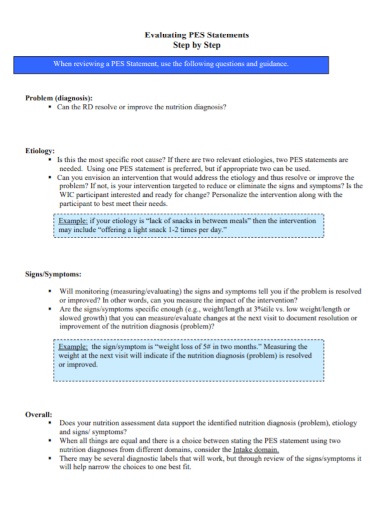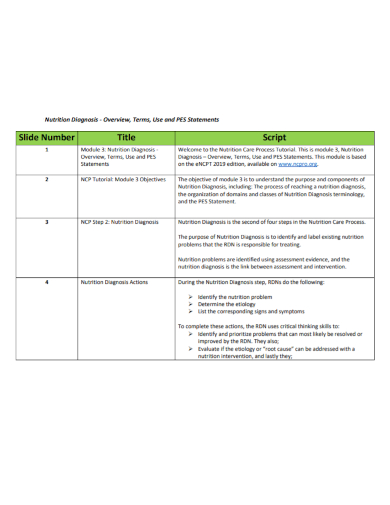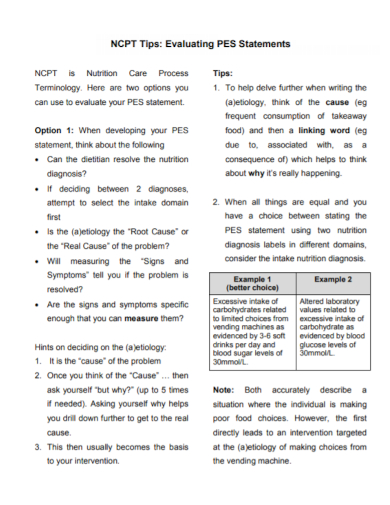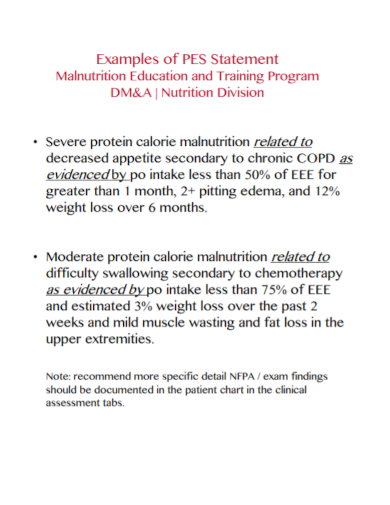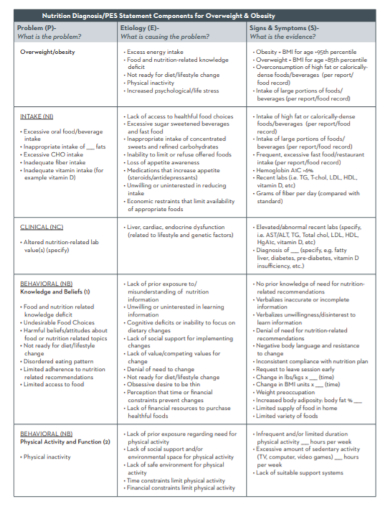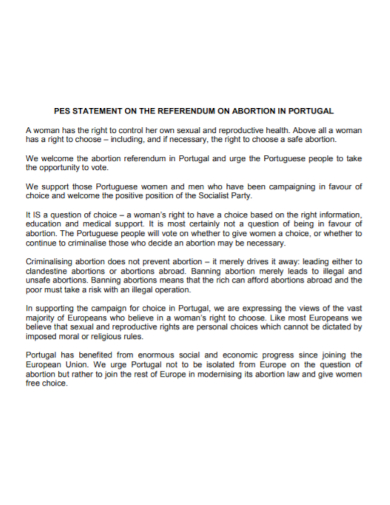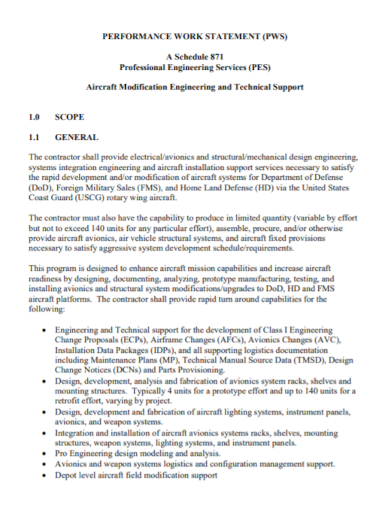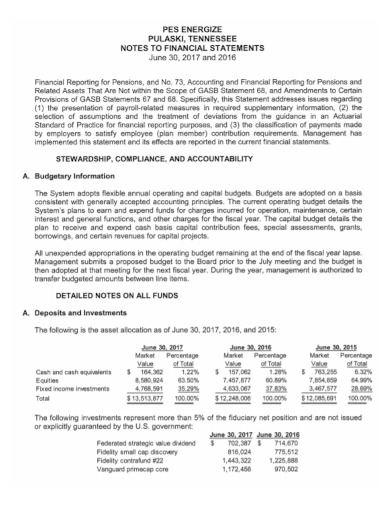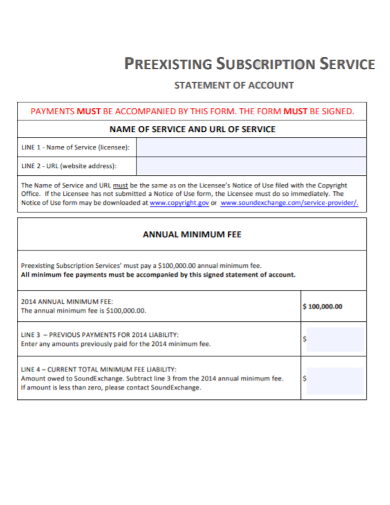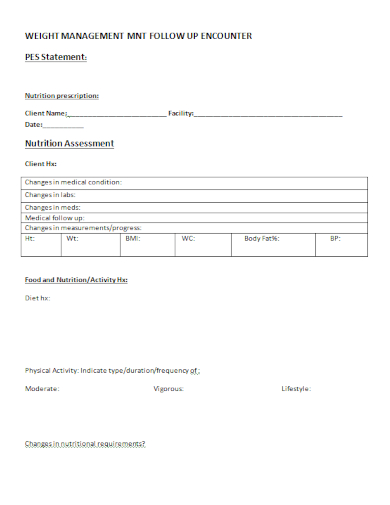Being a nutritionist or a dietitian requires a lot of work and study to determine the best nutrition for people. However, with so many harmful products and other environmental and behavioral factors that people are exposed to almost every day, people could have weak nutrition health. Nutritionists are the experts that assess every person’s different nutrition deficiencies, and in order to do that, he needs to make a PES statement. But making one can be a challenge, even for experienced nutritionists. But fear not! This article will give you tips to write the best PES statement with sample templates provided below.
10+ PES Statement Samples
1. Evaluating PES Statement
2. Nutrition Diagnosis PES Statement
3. Nutrition Evaluating PES Statement
4. Malnutrition PES Statement
5. Nutrition Diagnosis PES Statement for Obesity
6. Abortion PES Statement
7. Nutrition Diagnosis Domain PES Statement
8. PES Performance Work Statement
9. PES Note Financial Statement
10. PES Account Statement
11. PES Nutrition Prescription Statement
What is a PES Statement?
A PES Statement, or also called Nutrition Diagnosis Statement, basically describes the specific nutrition problem that dietitians are responsible for diagnosing the root cause of the problem in a person’s health that is related to his nutritional diet, treating the problem, and finding the evidence that the problem actually exists.
There are three components that make up the PES statement. These are: Problem (P), also called the Nutrition Diagnosis, Etiology (E); this component describes the cause of the nutrition problem, and Signs and Symptoms (S); where the evidence of a nutrition problem is proven that caused the problem.
To understand the importance of making a PES Statement, it’s important to know about the Nutrition Care Process (NCP). The Nutrition Care Process entails the specific steps on diagnosing a patient’s nutritional health to help provide him better nutrition care. There are four steps of the NCP. These are
- Nutrition Assessment; this is the part where the patient’s food and nutrient intake information is obtained through medical tests and procedures,
- Nutrition Diagnosis; which is where the process of making a PES Statement is done,
- Nutrition Intervention; this is when the nutritionist works to improve the diagnosis with interventions, and lastly the
- Nutrition Monitoring and Evaluation, when the nutritionist assesses the improvement of the diagnosed patient.
How to Make the PES Statement
Since the PES Statement is a structured sentence, the format should always be followed.
This is the main format of the PES statement: The Problem (the nutrition diagnosis) related to Etiology (causes that contribute to the nutrition diagnosis) as evidenced by Signs and Symptoms (evidence that the nutrition problem from the nutrition assessment exists.)
1. The Problem
The Problem, or also called Nutrition Diagnosis, a terminology used from the Electronic Nutrition Care Process Terminology (eNCP) should identify the specific nutrition problem that the nutritionist is going to resolve. The problem has three classifications: Intake (intake of food-related problems), Clinical (medical conditions that affect the patient’s nutrition), and Behavioral (Behavior or beliefs that affect the nutritional health of the patient.)
2. The Etiology
The Etiology describes the root cause or the contributing factors of the Problem (Nutrition Diagnosis) in the PES statement. The Etiology is important since it helps identifies the type of nutrition intervention that is needed to do to resolve the Problem.
3. The Signs and Symptoms
Signs and Symptoms are evidence gathered by the nutritionist through physical examination, patient’s report according to his nutrition knowledge and history, observation, and test results that support the Problem (Nutrition Diagnosis). The Signs and Symptoms should be specific since this will be monitored by the nutritionist to evaluate its changes once the nutrition intervention is done.
FAQs
What is the difference between medical diagnosis and nutrition diagnosis?
The nutrition diagnosis focuses on the nutrition problem of a person that can be treated by nutrition intervention while a medical diagnosis identifies a disease in the organs of the body.
What is the importance of nutrition diagnosis?
The main purpose of a nutrition diagnosis is to identify a nutrition problem of a person that can be improved through nutrition intervention (treatment) by a dietitian or a nutritionist.
How many categories of nutrients are there?
There are six main categories of nutrients. These are carbohydrates, lipids or fats, proteins, vitamins, minerals, and water.
Writing a PES Statement is easier said than done. If your PES statement is not accurate enough to address the urgent problem, the interventions won’t likely work and the goal of improving the problem will fall short. However, if the PES Statement is able to identify the problem correctly, it will work wonders on improving the patient’s health. Studying and assessing the diagnosis will take some time in order to write an effective PES Statement. If you’re looking for more help on writing statements relating to the medical field, we have provided a lot of articles with writing tips and downloadable forms. Head over to these sample statement templates and download them now!
Related Posts
FREE 10+ Sample Research Statement
FREE 9+ Statement of Purpose Templates
FREE 9+ Sample Safety Statement
FREE 9+ Sample Personal Statement
FREE 7+ Sample Business Statement
FREE 14+ Employer Statement Samples
FREE 14+ Compliance Statement Samples
FREE 14+ Travel Expense Statement Samples
FREE 12+ Personal Financial Statement Samples
FREE 11+ Pro Forma Income Statement Templates
FREE 10+ Statement of Facts Samples
FREE 10+ Legal Statement Samples
FREE 10+ Written Statement Samples
FREE 9+ Warranty Statement Samples
FREE 9+ Sample Personal Statement

